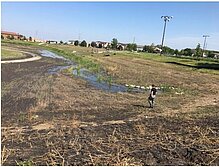Performance of a Retrofit Detention basin in Fargo, ND

Cole Huggins is a MS Environmental and Conservation Science student. His post-secondary education from Minnesota State University Mankato BS Geology and GIS certificate. Research Specialization in Hydrology.
Performance of a Retrofit Detention basin in Fargo, ND
- The Rabanus detention basin (Fargo, ND) was retrofitted from a traditional concrete-lined channel and mowed grass basin to a basin with an earthen-channel, sediment forebay, and native vegetation.
- The goals of the study were to assess the performance between preretrofit concrete-lined channel and post-retrofit earthen-channel with respect to flood frequency for small storms, and to estimate ponding time, infiltration, and evaporation of the retrofit basin for various storm sizes/intensities.
- Monitoring occurred between May 1, 2018 and September 30, 2018 using an Onset HOBO Weather Station and various in-channel Onset HOBO Water Level Loggers. A drone flight and manual survey of the channel and sediment forebay were also conducted in order to estimate a DEM from structure-from-motion techniques within Pix4D.
- HEC-RAS was used to estimate and compare post-retrofit channel flow with pre-retrofit channel capacity of small storms.
- The ArcMap’s ModelBuilder was used to estimate hourly ponded volume and ponding time of each storm.
- Hydrus-1D was used to estimate infiltration and evaporation during ponding time of the select storms. The Penman-Monteith equation for evaporation was also solved within Hydrus-1D using the monitored weather data.
- The northern-most post-retrofit channel behaves similarly to the pre-retrofit channel in terms of flood frequency due to increased erosion of the earthen-channel. The southern post-retrofit channel floods significantly more often than the pre-retrofit channel, leading to a potential increase in ponding time, infiltration, and evaporation.
- 50% of the storms had a ponding time equal to or greater than 9 hours, while 40% of the storms had a ponding time equal to or greater than 12 hours. It is apparent that sediment re-mobilization occurred, and the sediment was deposited at the outlet.
- Combined total infiltration and evaporation for ponding time of the selected storms averaged 7.90% of the respective peak ponded volume. Evaporation was relatively negligible in comparison to infiltration.

Stephanie Day
Geosciences
Office: Stevens 228
Telephone: 701-231-8837
Email: stephanie.day@ndsu.edu


